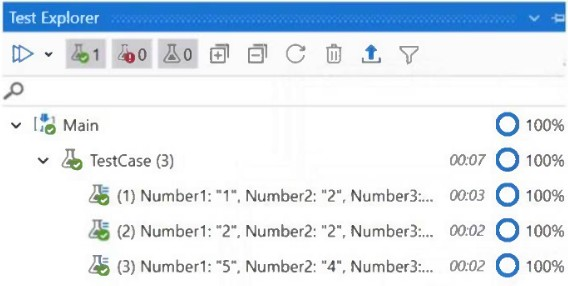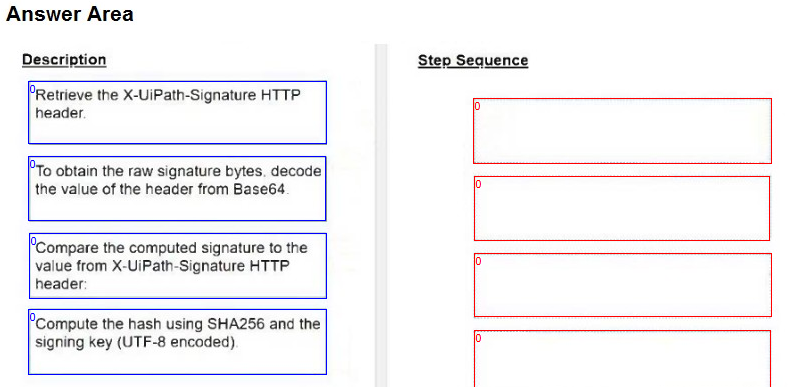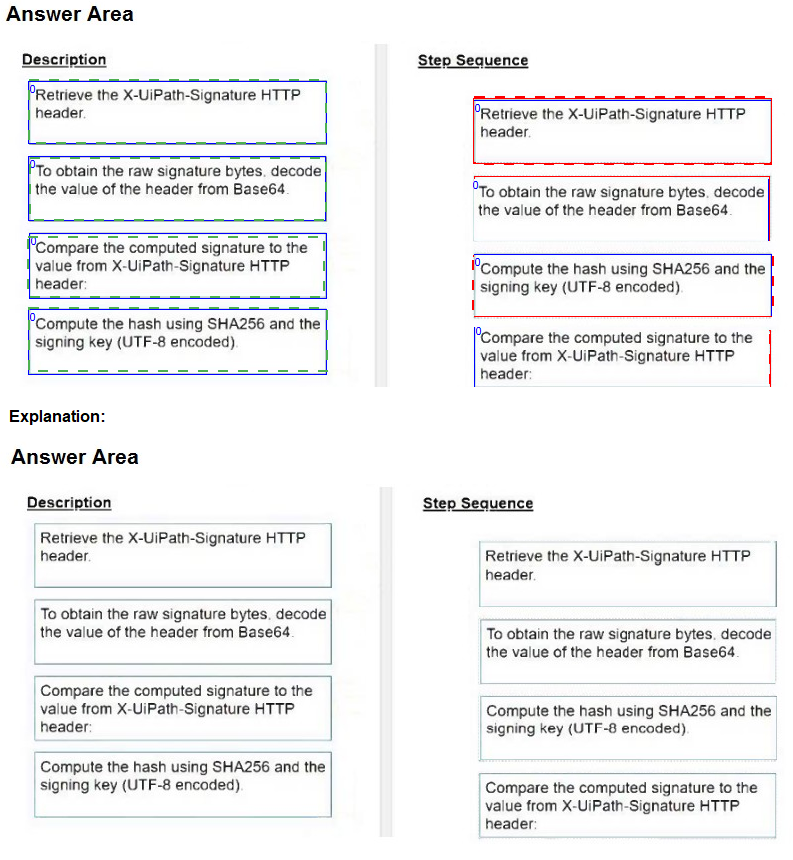A developer designed a project in the REFramework. The "Config.xlsx" has me following
Setting entry:
Assuming the default REFramework configuration, how can the developer reference the
Setting in the Config variable to obtain the Setting value as a String from the dictionary?
A. Config (“OrchestratorOueueName"." Process ABCQueue" )ToString
B. Config (“OrchestratorOueueName ).ToString
C. Config (“ProcessABCQueue"."OrchestratorQueueName").ToString
D. Config (“ProcessABCOueue")ToString
Which of the following describes the correct hierarchy of the elements in the Object Repository tree structure?
A. Version, Application, Screen, Ul Element.
B. Application, Version, Screen, Ul Element.
C. Application, Screen, Ul Element, Version.
D. Screen, Application, Version, Ul Element.
Explanation: The Object Repository in UiPath organizes elements in a hierarchical
structure that reflects the logical arrangement of user interfaces and elements as they are
captured and used in automation projects.
The correct hierarchy for elements in the Object Repository tree structure is:
A. Version, Application, Screen, UI Element.
This hierarchy starts with the 'Version', which could refer to the specific version of the
application you are automating. Under each version, there could be multiple 'Applications'
that you have elements for. Within each application, you might have captured various
'Screens' or dialogs, and within each screen, there are individual 'UI Elements' like buttons,
text fields, dropdown menus, etc., that the automation interacts with.
However, it's important to note that in practice, when you are working with UiPath Studio
and its Object Repository, the hierarchy usually starts with the 'Application', then under it,
you have different 'Screens' of the application, and under each screen, you have the 'UI
Elements'. The 'Version' is typically managed separately and is not a level in the hierarchy
tree but rather a property or attribute of the application or element. Therefore, the most
practical answer reflecting the usage in UiPath Studio would be:
C. Application, Screen, UI Element, Version.
The 'Version' here would be understood not as a layer in the hierarchy but rather as an
attribute that can be associated with the 'Application' or 'UI Element'.
What status needs to be selected in the Set Transaction Status activity in UiPath Studio so that the respective Queue Item will be retried?
A. Retried
B. Failed
C. Abandoned
D. Postponed
Explanation:
The Set Transaction Status activity in UiPath Studio is used to set the status of an
Orchestrator queue item to Failed or Successful. This activity is usually placed at the end of
the Process Transaction state in the REFramework template, after the Try Catch block.
The status of the queue item determines whether it will be retried or not.
To retry a queue item, the status needs to be set to Failed. This means that the transaction
was not completed successfully, and it needs to be processed again. The number of retries
for a queue item depends on the MaxRetryNumber parameter in the Config file of the
REFramework. By default, it is set to 2, which means that each queue item can be retried
twice before it is marked as permanently failed.
The other options are not valid statuses for the Set Transaction Status activity. Option A is
incorrect, because Retried is not a status, but a property of a queue item that indicates
whether it has been retried or not. Option C is incorrect, because Abandoned is a status
that is automatically assigned by Orchestrator to a queue item that has been in progress for
more than 24 hours, and it cannot be retried. Option D is incorrect, because Postponed is a
status that is automatically assigned by Orchestrator to a queue item that has a specific
start date in the future, and it cannot be retried until that date is reached.
Which LINQ method is used to filter data in a List or DataTable based on a condition?
A. Select
B. GroupBy
C. OrderBy
D. Where
Explanation:
LINQ (Language Integrated Query) is a feature of .NET that allows you to write queries to
manipulate data from various sources, such as arrays, collections, databases, or XML files.
LINQ provides a set of methods that can be used to perform different operations on the
data, such as filtering, sorting, grouping, aggregating, or transforming.
The LINQ method that is used to filter data in a List or DataTable based on a condition is
Where. The Where method returns a new collection that contains only the elements that
satisfy the specified condition. The condition is usually a lambda expression or a delegate
that takes an element as a parameter and returns a Boolean value. For example, if you
have a List of integers called numbers, you can write:
var evenNumbers = numbers.Where (x => x % 2 == 0);
This expression returns a new List that contains only the even numbers from the original
List. Similarly, if you have a DataTable called employees, you can write:
var highSalary = employees.AsEnumerable ().Where (row => row.Field
This expression returns a new DataTable that contains only the rows where the Salary
column is greater than 100000. The AsEnumerable () method is used to convert the
DataTable into an IEnumerable
The other options are not LINQ methods that are used to filter data in a List or DataTable
based on a condition. Option A, Select, is a LINQ method that is used to project or
transform data from one form to another. It returns a new collection that contains the result
of applying a function to each element of the source collection. Option B, GroupBy, is a
LINQ method that is used to group data by a common key or attribute. It returns a new
collection that contains groups of elements that share the same key value. Option C,
OrderBy, is a LINQ method that is used to sort data in ascending order by a specified
criterion. It returns a new collection that contains the elements of the source collection in
sorted order.
When a developer runs a process using the REFramework, with the process utilizing Orchestrator queues and a queue already created with the Name provided and the Auto Retry function disabled, which states will be executed without errors?
A. Initialization -> Get Transaction Data -> Process Transaction -> End Process
B. Initialization -> Get Transaction Data -> End Process
C. Initialization -> Process Transaction -> End Process
D. Initialization -> End Process
Explanation: The states that will be executed without errors when a developer runs a process using the REFramework, with the process utilizing Orchestrator queues and a queue already created with the Name provided and the Auto Retry function disabled, are Initialization, Get Transaction Data, Process Transaction, and End Process. The REFramework is a template that provides a robust and scalable structure for building automation processes. The REFramework consists of four main states: Initialization, Get Transaction Data, Process Transaction, and End Process. The Initialization state is responsible for initializing the application, reading the configuration file, and logging in to the Orchestrator. The Get Transaction Data state is responsible for fetching the next transaction item from the Orchestrator queue and assigning it to the TransactionItem variable. The Process Transaction state is responsible for executing the main logic of the process for the current transaction item. The End Process state is responsible for closing the application, logging out of the Orchestrator, and performing any cleanup actions. If the process utilizes Orchestrator queues and a queue already exists with the Name provided and the Auto Retry function disabled, then the process will be able to execute these states without errors, assuming that there are no other issues or exceptions in the workflow.
In a UiPath development scenario, which type of process design would be the most appropriate for an automation task that executes actions in a straightforward progression without iteration or branching?
A. Transactional Process
B. Iterative Process
C. Sequential Process
D. Linear Process
Explanation:
A sequential process is a type of process design that executes actions in a
straightforward progression without iteration or branching. A sequential process is
composed of a series of activities that are executed one after another, from top to bottom,
in a linear fashion. A sequential process is best suited for simple scenarios when activities
follow each other and there is no need for complex logic or decision making12.
The other options are not appropriate for an automation task that executes actions in a
straightforward progression without iteration or branching, because they involve different
types of process design that require more complex structures and logic. For example:
A transactional process is a type of process design that executes actions on a set
of data items, one at a time, in a loop. A transactional process is composed of a
dispatcher that adds data items to a queue, and a performer that processes each
data item from the queue and updates its status. A transactional process is best
suited for scenarios when activities need to be repeated for each data item and
there is a need for reliability and scalability34.
An iterative process is a type of process design that executes actions repeatedly
until a certain condition is met or a certain number of iterations is reached. An
iterative process is composed of a loop that contains a set of activities and a
condition that controls the exit of the loop. An iterative process is best suited for
scenarios when activities need to be performed multiple times and there is a need
for dynamic control of the execution flow56.
A linear process is not a type of process design, but a term that refers to a process
that has a clear start and end point, and a well-defined sequence of steps that lead
to a specific outcome. A linear process can be implemented using different types
of process design, depending on the complexity and logic of the steps involved7.
"Process A" is scheduled to run at 2:00 PM using a time trigger with the Schedule ending of Job execution feature configured to stop the job after 20 minutes. Assuming that the robots are busy and "Process A" is queued until 2:05 PM. at what time will "Process A* be stopped?
A. 2:20 PM
B. 2:25 PM
C. 2:05 PM
D. 2:28 PM
Explanation:
"Process A":
What is a prerequisite for performing Remote Debugging using an Unattended Robot connection?
A. Studio and the remote robot have the same version.
B. TCP/IP connectivity exists between the Studio machine and the remote machine
C. The same user must be signed in Studio and the remote robot.
D. Studio and the remote robot must be connected to the same Orchestrator tenant.
Explanation:
On the prerequisite for performing Remote Debugging using an Unattended Robot
connection:
When building automation projects, which statement is true regarding Perform Remote Debugging?
A. Perform Remote Debugging is only possible when the automation project does not involve Orchestrator queues and assets.
B. Perform Remote Debugging enables developers to design new III elements for the automation project.
C. Perform Remote Debugging refers to the process of testing and debugging an automation project on the same machine where UiPath Studio is installed.
D. Perform Remote Debugging allows developers to debug a project on a different machine using a web-based interface.
Explanation:
Comprehensive and Detailed Explanation: Remote Debugging is a feature
of UiPath Studio that allows developers to run and debug automation projects on robots
deployed to remote machines, including on Linux robots that can run cross-platform
projects1. It enables developers to connect to the remote robot using either a remote
machine connection or an unattended robot connection, and then use the Studio
debugging tools to inspect the execution and troubleshoot any issues1. Remote Debugging
uses a web-based interface that shows the UI elements and the data of the remote
machine, as well as the breakpoints, variables, and output of the project2.
The other options are incorrect because:
What do the percentages from the Test Explorer panel represent?

A. Percent of test data run.
B. Correctness of the code percent.
C. Coverage percent.
D. Passing percent.
Explanation: The percentages from the Test Explorer panel represent the passing percent of the test cases that are executed. The Test Explorer panel shows the status of each test case, the total number of test cases, the number of passed test cases, the number of failed test cases, and the passing percent. The passing percent is calculated by dividing the number of passed test cases by the total number of test cases and multiplying by 100. For example, if there are 10 test cases and 8 of them pass, the passing percent is 80%.
How should the computation of the signature be done for client apps that receive
Orchestrator requests and need to check their authenticity?
Instructions: Drag the Description found on the left and drop on the correct Step Sequence
found on the right.


A developer has defined a variable named "CurrentDate" of type Date Time. Which of the following expressions can be used to show what hour was 12 hours prior to the date from the variable?
A. DateTime.AddHours(CurrentDate, -12).Hour
B. CurrentDate.AddHours(-12).Hour
C. CurrentDate.SubtractHours(12).Hour
D. DateTime.SubtractHours(CurrentDate, 12).Hour
Explanation:
In UiPath Studio, you can use DateTime and TimeSpan variables to store and manipulate
date and time values. A DateTime variable represents a specific point in time, such as the
current date and time, or a date in the past or future. A TimeSpan variable represents a
time interval, such as one hour, two days, or three weeks.
To show what hour was 12 hours prior to the date from the variable, you can use the
AddHours method on the DateTime variable and pass a negative value. For example, if
you have a DateTime variable called CurrentDate that stores a date and time value, you
can write:
CurrentDate.AddHours(-12).Hour
This expression returns an integer value that is the hour component of the DateTime value
that is 12 hours before the CurrentDate value. For example, if CurrentDate is 2024-02-08
10:51:49, then the expression returns 22.
The other options are not correct expressions for showing what hour was 12 hours prior to
the date from the variable. Option A is invalid, because the DateTime class does not have
an AddHours method. Option C is incorrect, because the DateTime variable does not have
a SubtractHours method. Option D is incorrect, because the DateTime class does not have
a SubtractHours method.
| Page 4 out of 16 Pages |
| Previous |